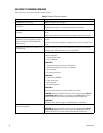
C1528M-F (6/05) 99
Glossary
Access The CM6800E allows you to restrict system control by (1) limiting the monitors or cameras a
keyboard can access, or (2) limiting the cameras that can be viewed on a monitor.
Alarm display format The CM6800E Matrix Switcher provides four formats for displaying alarmed cameras on system
monitors: Block Build, Chronological Pair, Reverse Chronological Pair, and Salvo Group.
Alarm group To display on a monitor, an alarm must be assigned to one or more alarm groups. The
CM6800E-48X8 Matrix Switcher provides eight alarm groups (A through H). The CM6800-32X6
Matrix Switcher provides six alarm groups (A through F). Refer to Alarm Groups and Alarm Group
Display Options.
Alarm priority A priority alarm appears on system monitors before a non-priority alarm. Refer to the Priority
description under Internal and External Alarms.
ASCII The binary, 7-bit, 128-character set implemented as the standard in communications.
Auxiliary Output relays can be used to control external devices based on matrix switcher activities. External
devices can include VCRs, alarm devices, and triggers for audio circuits.
Baud rate In video, the greater the speed, the larger amount of information passed. In digital systems, this
capacity is given in bits per second, or baud rates.
Bit An abbreviation for “binary digit” – the smallest unit of information a computer can use. A bit is
either a 1 or a 0 (a high or low voltage state).
Byte An abbreviation for “binary term” – bytes are strings of bits, operated upon as a unit. A byte is
equal to eight bits (256 possibilities) and is large enough to hold one character (like an “A” or the
number “1”.)
Camera auxiliary Some cameras contain an auxiliary output relay, which can be used to operate a device connected to
the relay.
Coaxitron This is Pelco’s “up the coax” control technology. Control signals are sent back up the coaxial cable
that the video signal travels down on.
COM port This is a communication port input on the rear panel of the matrix switcher.
Cross-point video matrix switcher A matrix switcher that can select any video input onto any video output at any time.
Daisy-chain This is a way of providing multiple connections in a series, from one source. A daisy-chain
configuration connects multiple, linked devices from one output. When connecting PTZ cameras to a
matrix switcher, for example, one set of cables connects the matrix switcher to each receiver, and
then each receiver is connected to the next receiver.
Dwell This is the amount of time something happens in the system, such as the amount of time a camera
view displays on a monitor, or an auxiliary is on.
Event timer The matrix switcher can automatically initiate macros or sequences based on time and date.
Extended Coaxitron This is Pelco’s Coaxitron control technology that uses 32 bits to send a command.
Frame scan A three-second camera scan (pan) followed by a three-second pause.
Latching operation The auxiliary device remains on until a command is given (by a system operator or system
automation) to turn it off.
Logical camera number A user-selectable, variable number, which is associated with an actual physical camera input on the
rear panel of the matrix switcher.
Macro A sequence of commands or steps. Macros can be operated automatically or manually. Automatic
operation can be based on specific times or dates (set through the Event Timer).


















